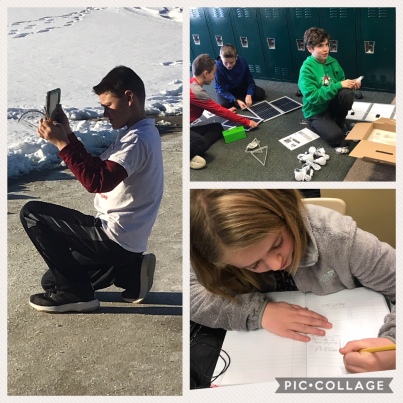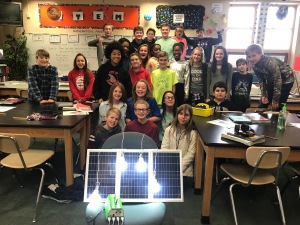
Two Sand Creek Intermediate classrooms will be solar powered soon, thanks to the 6th grade STEM classes of Jennifer Suskovich. HSE21 Shorts asked Mrs. Suskovich about the project’s origins, and about what her students are learning in the process. (Process – hmmm…that word sounds familiar from our last post…)
Q: This is a huge undertaking. What gave you the initial idea?
A: I moved to a new classroom this school year, and wanted to utilize an area outside of school for an outdoor learning space. I had the class brainstorm some ideas we could explore out there. A student mentioned using the space to gather solar energy. The students agreed that this would be an interesting activity that they hadn’t really explored before. Coincidentally, I had spent a day this summer at the Purdue SLED training and one of the training topics was building a solar tracker prototype. I began writing the grants to purchase solar panels with light kits and solar generators in September. By the beginning of February, I had all of the light kits purchased for two classes. We are waiting to have them installed by an electrician.
Q: So, how does this relate to STEM (science, technology, engineering, and math) Academic Standards for 6th graders?
 A: This project will challenge students to use their science based knowledge on the daily/seasonal solar movements to find the ideal location to place solar panels and increase the amount of time our class is powered by solar energy. Technology will be utilized to run the system that tracks the sun throughout the day. Students will use the engineering design process to work collaboratively to create solar tracking prototypes, test, and redesign their systems. Students will use their mathematical knowledge to analyze data and decide on the angle the solar panels should be placed throughout the day to receive the maximum amount of sunlight. Finally, students will collaborate with the art department to ensure that the designs for the solar panel tracking systems are aesthetically pleasing on our school grounds.
A: This project will challenge students to use their science based knowledge on the daily/seasonal solar movements to find the ideal location to place solar panels and increase the amount of time our class is powered by solar energy. Technology will be utilized to run the system that tracks the sun throughout the day. Students will use the engineering design process to work collaboratively to create solar tracking prototypes, test, and redesign their systems. Students will use their mathematical knowledge to analyze data and decide on the angle the solar panels should be placed throughout the day to receive the maximum amount of sunlight. Finally, students will collaborate with the art department to ensure that the designs for the solar panel tracking systems are aesthetically pleasing on our school grounds.
Q: What happens next – after the electrician installs the light kits?
A: Once the panels are installed, the project will be broken down into the following phases:
Phase 1 Focus Question: How does the sun move both daily and seasonally?
Students will collect data on where to place solar panels to receive the maximum amount of daily solar energy. Students will graph this data and analyze the daily, weekly and monthly movements and energy collection to determine the optimum angles for the solar panel
Phase 2 Focus Question: How can we build a device that moves with the sun to maximize the amount of time our class is powered by solar energy vs. electricity?
Students will create small solar tracking prototypes. The prototypes must be capable of the movements necessary for tracking daily and seasonal solar actions. Students will then evaluate competing design solutions using a systematic process to identify how well they meet the criteria and constraints of the problem. The class will identify the best characteristics of each design that can be combined into a new solution to better meet the criteria for success.
Phase 3 Focus Question: How can our solar tracking device move on its own?
Students will explore various systems to decide if our solar trackers should move with motors, computers, hydraulics, etc. Our class has contacted Taylor University to discuss features of their Heliostat Atrium and how the drive system aligns the circular mirror to track the sun. We have also contacted The Indianapolis International Airport Solar Farm and the IMPA Richmond Solar Power Park for research and informational purposes. The classes will build and test designs to determine which tracking system gathers the maximum amount of solar energy while meeting the constraints of money and technology.
 Phase 4 Focus Question: How can we make our solar tracking devices aesthetically pleasing on our school grounds?
Phase 4 Focus Question: How can we make our solar tracking devices aesthetically pleasing on our school grounds?
The panels will be facing the main road in front of our school building. Students will be working with the art teachers to transform the designs into interesting and creative art pieces while keeping the integrity and function of the solar tracking systems.
Impressive!
LikeLike
Amazing! So thrilled to hear about this and to know that our kiddos are doing this real world work!
Great job!
LikeLike
This is very impressive! So proud of our students!
LikeLike
Pingback: Solar Energy for SCI – SEO
This is a great opportunity for the students to think of the big picture. Taking care of what has been handed down to thier generation. Saving our natural resources, and planet, one school at a time.
LikeLike